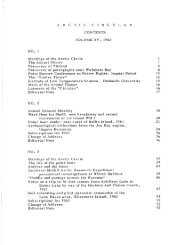Volume 11, 1958 - The Arctic Circle - Home
Volume 11, 1958 - The Arctic Circle - Home
Volume 11, 1958 - The Arctic Circle - Home
You also want an ePaper? Increase the reach of your titles
YUMPU automatically turns print PDFs into web optimized ePapers that Google loves.
VOL. Xl No, 4<br />
THE ARCTIC CIRCULAR<br />
71<br />
4. <strong>The</strong> last phase is marked by the concentration of the<br />
groups along Povungnituk Bay. the adoption of new<br />
hierarchal forms (elected chiefs and group accounts).<br />
the increased relief distributed by the Federal<br />
Government, the introduction of new occupational<br />
activities (carving), the development of trade, and a<br />
decrease in hunting. During this last period the<br />
acculturation process seems to be intensified and can<br />
be analysed in relation to the corresponding period at<br />
Great Whale River,<br />
<strong>The</strong> following tendencies seem quite well established: a<br />
concentration into larger more stable communities and longer<br />
individual hunting and trapping trips. the immediate acquisition of<br />
more efficient weapons and tools whenever possible, and an increase<br />
in the volume of trade and occupational diversification, However,<br />
some resistance to the creation of complex organizational forms<br />
and the appearance of messianic movements show that these<br />
Eskimos are still a lone way from identification with Canadian<br />
society to the south.<br />
Folklore material, folk tales, local legends, folk songs,<br />
and traditional cames were also collected. <strong>The</strong> basic vocabulary<br />
was recorded on tape at both settlements and traditional artifacts,<br />
mainly models, were'·'ta.:,H 'y:, Some of these are now being<br />
shown in the National Museum and a large collection of carvings<br />
depicting legends is being assembled at Povungnituk and will form<br />
the centre of another temporary exhibition,<br />
Geographical Bra.nch survey on Melville Peninsula, <strong>1958</strong> 1. By<br />
Victor W. Sim<br />
In 1957 the Geographical Branch of the Department of<br />
Mines and Technical Surveys began a study of the physical and<br />
human geography of the northern part of Melville Peninsula<br />
(<strong>Arctic</strong> Circular, Vol. <strong>11</strong>, No.2, pp. 27-9). During the field<br />
season of <strong>1958</strong> 1 continued this study with the assistance of Richard<br />
-<br />
Moskal, an undergraduate at the University of Western Ontario.<br />
I reaChed Hall Beach on the east coast of the peninsula<br />
by air from Frobisher Ba.y on May 16. Unfortunately, Moskal wa.s<br />
I<br />
1 Published with the permission of the Director, Geographical<br />
Branch, Department of Mines and Technical Surveys, Ottawa,<br />
\












